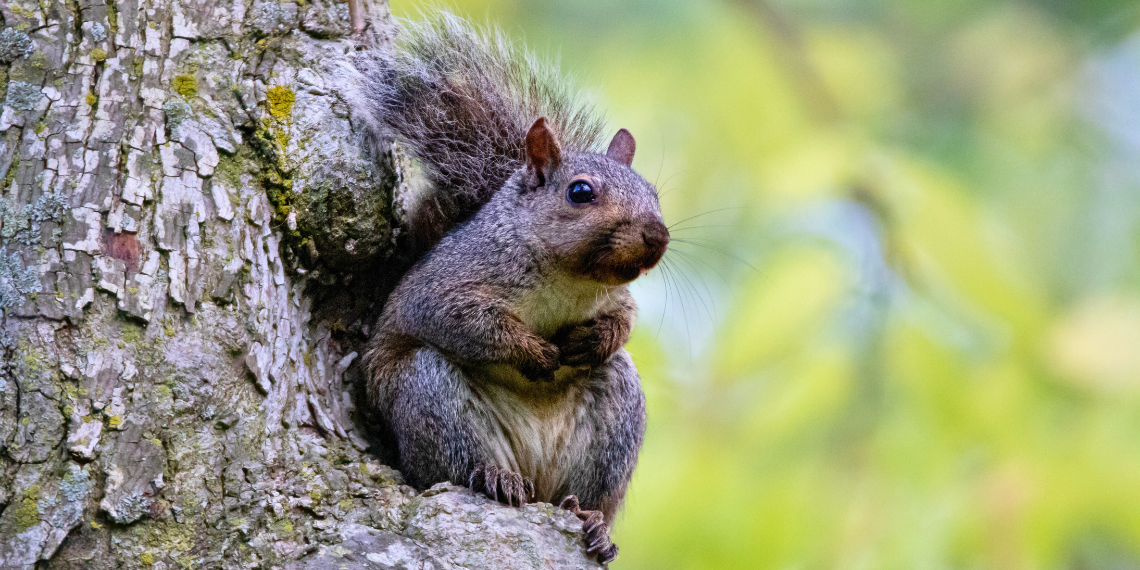Winter is Coming: How Seasonality May Impact Grey Squirrel Gut Microbiomes

The dumpster-diving squirrel can be thought of as the unofficial mascot of city living. As fun as it can be to watch a squirrel wrestle a jar of peanut butter, rarely do people stop and think about how city living has impacted these familiar critters — or their gut microbiome.
This is what animal physiologist Dr. Amy Newman in the Department of Integrative Biology and her research group are interested in understanding. They recently set out to determine how environmental stressors, such as seasonality and urban living, affect the composition of the gut bacteria in grey squirrels.
“We wanted to look at how urban living and seasonality impact the gut microbiomes of squirrels, considering that gut microbiomes are known to play a role in shaping animal’s health, behaviour and ‘ecological niche,’” explains Hayley Spina, a PhD candidate who co-led the research with Mason Stothart, a postdoctoral researcher and former Newman Lab MSc student.
In a study published in Ecology and Evolution, the team found that the shifts in microbiome composition between seasons in urban squirrels were distinct from the shifts seen in their “exurban” counterparts — that is, squirrels living in more natural areas outside of city limits.
To do this, the team needed fecal samples. And to get fecal samples, the team needed to catch some squirrels.
“Urban squirrels are easier to catch than exurban, but both are harder to catch in the fall,” says Spina. While some might consider it a “crappy” job to collect them, feces are an excellent way to study mammalian gut microbiome composition.
Comparing microbiome shifts in response to seasonal change was an important feature of this study, notes Spina, since most mammalian microbiome studies are done within a single season. “It’s important for scientists to think about when and where they’re collecting their data and how that may impact their results.”
The differences in seasonal microbiome patterns in squirrels in the city compared to their forest dwelling counterparts likely comes down to the availability of food — and the content of that food.
“Exurban squirrels have a more consistent diet across the years compared to urban squirrels, likely because urban squirrels don’t rely as strongly on the seasonality of natural food sources,” explains Spina.
For all squirrels, spring and summertime saw less of a shift in their microbiomes, while fall saw the greatest. Grey squirrel microbiomes appeared to be well-adapted to the wide variety of food available during the warmer months, with the dramatic changes seen in the fall likely related to reduction in food availability and metabolic changes as the external temperature begins to decline.
Despite differences in microbiome composition for most of the year, both urban and exurban squirrels converged during the fall.
The one compelling explanation for this similarity, say the researchers, may be related to squirrels’ well-known propensity for nut collecting. Despite having access to abundant food sources year-round, urban squirrels are still driven to collect nuts in the fall. This instinctual behaviour may help to promote the same microbes in both urban and exurban environments.
With less reliance on seasonality for food sources, the team’s study has also shown that the gut of the urban squirrel has developed a consistent, underlying signature “urban” microbiome. This signature microbiome can be correlated to the high-fat, high-protein human food commonly available to city-dwelling squirrels. However, differences in squirrel physiology between urban and exurban environments may also play a role, as suggested by previous studies.
While squirrels are popular study subjects that offer fascinating insights into animal ecology, physiology, and the impacts of urbanization on wildlife, the researchers note that their study goes well beyond squirrels. From a conservation perspective, the study is relevant to other areas including food supplementation for birds and other wildlife during winter, or animals maintained in captivity for short or long-term programs. It also sheds light on how environmental stressors can impact animal health.
“Squirrel populations are doing pretty well; this research though goes a lot broader than squirrels in the area of conservation biology,” says Spina.
Read the full study in Ecology and Evolution.
Read about other CBS Research Highlights.